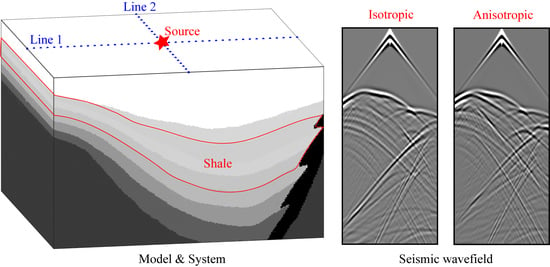Impact of Shale Anisotropy on Seismic Wavefield
Abstract
:1. Introduction
2. Methodology
2.1. Forward Modeling for 3D TTI Model
2.2. Quantitative Evaluation of the Shale Anisotropy’s Impact
- Set the parametric medium model M0 (without anisotropy) according to the geological characteristics of shale reservoirs or the actual oilfield models. Add three sets of different anisotropic parameters to the shale layer of model M0 and establish three different medium models with shale anisotropy, i.e., ME ( = 0.25, = 0), MD ( = 0, = 0.25), and MED ( = 0.25, = 0.25). The parameters of model MED are reasonably geologically chosen from several shale anisotropy studies in China ([9,17]), while the other two models (ME and MD) are built based on the variable-controlling approach, for the purpose of exploring the impact of different anisotropy parameters;
- Use the forward modeling method to calculate the elastic wavefields of four medium models ( for model M0, for model ME, for model MD, and for model MED);
- Compare the seismic wavefields with each other and calculate the envelope misfit EM and the phase misfit PM of the wavefield // from . Evaluate the impact of shale anisotropy on elastic seismic wave response.
3. Evaluation of Simulation Models
3.1. Horizontal Layered VTI Model
3.1.1. Parameters and Wavefield Data
3.1.2. Effect of Anisotropy on Different Seismic Phases
- Direct P wave. The first seismic phases (direct P wave) of two models are exactly the same. From its propagation path (Figure 3d), we can see that the direct P wave traveled from the seismic source to the detector through the surface, so it is not affected by the shale anisotropy.
- Transmitted and reflected P-P-P-P wave. The fourth seismic phases (P-P-P-P wave, its propagation path is shown in Figure 3d) are totally different. When adding anisotropy to the shale layer, the velocities of P-waves along different directions propagating in it are changed and not the same. So this seismic wave’s arrival time, amplitude and phase are all influenced by shale anisotropy.
- Reflected P-P wave and P-SV wave. The arrival time of the second and third phases (reflected P-P and P-SV waves, their paths are shown in Figure 3d) is the same, while their amplitudes are different. The reasons for this are probably because:
- Arrival time. These two waves are both reflected at the interface of the first layer and the shale layer. The first layer is isotropic, so we can use the Snell’s law to analyze the reflection:where is the velocity of incident P-wave (same as the reflected P-wave’s velocity) and is the reflected SV-wave’s velocity at the interface, respectively, and are the corresponding angles (Figure 5a). When we added anisotropy to the shale layer, velocities of P and S wave in the first layer are not changed, so and remain unchanged. From Equation (6), we can find that , , and the propagation paths are not influenced by anisotropy, so is the arrival time.
- Amplitude. The amplitude of reflected P and SV waves can be evaluated using the anisotropic reflectivity and transmissivity calculator code by Malehmir and Schmitt [19]. According to the observation system and source location (Figure 2), the maximum incident angle of P wave between the first and second (shale) layer is about 32°. Then, we set from 0 to 35° and calculate the reflection coefficients of reflected P and SV waves. The differences of reflection coefficients with and without anisotropy are shown in Figure 5b. We can find that when adding anisotropy to the VTI model (Figure 2), the reflection coefficients of reflected P and SV waves are both changed. Considering that the propagation paths of these two waves are unchanged, so the Z-component amplitudes of reflected P-P and P-SV waves are influenced by the shale anisotropy.
3.1.3. Amplitude and Phase Misfit by Anisotropy
- The amplitude deviation EM and phase deviation PM of the two survey lines in Z-component are significantly larger than their X- and Y-components, which indicates that anisotropy has a more significant influence on the vertical component. It is speculated that the reason may be that the propagation distance of the seismic wave in the vertical direction is larger than that in the horizontal direction and the medium model’s symmetric axis is along the vertical direction.
- The maximum EM of the two survey lines in Z-component is greater than 1, which indicates that the waveform’s amplitude will be significantly affected by the shale anisotropy. In actual seismic exploration, the amplitude is of great importance to the inversion of reservoir parameters, so ignoring anisotropy may lead to errors in reservoir characterization.
- The Z-component phase deviation PM of the two survey lines reaches 0.4. As is mentioned above, if PM is 1, the polarities of the two signals are completely opposite. So this means that the waveforms’ phase morphology is also largely changed due to anisotropy. The inaccurate phase may lead to the low resolution of migration imaging results, which also affects the processing and interpretation of actual exploration seismic data.
- The amplitude deviation EM and phase deviation PM of X/Y/Z components on two sides of the source are symmetrical, which is caused by the symmetry axis’s verticality of the VTI model. Moreover, the EM all increases with the increase of epicentral distance (offset), while the PM increases first and then decreases. This may because the maximum value of the difference in phase is the odd multiples of π. Therefore, if the phase’s difference gradually increases from 0 to 2π, the difference in waveform’s phase will become bigger first and then smaller, and the calculated PM will also increase first and then decrease correspondingly.
- In most of the results, the deviations of the model MED ( = 0.25, = 0.25) are relatively larger than the other two models ME ( = 0.25, = 0) and MD ( = 0, = 0.25).
3.2. Curved Layered TTI Model
- Same as the VTI model, the EM and PM of Z-component are still larger than that of X- and Y- components. The maximum EM is still greater than one, and the maximum PM is about 0.5 (relatively large; if PM is 1, the polarities of all phases of the two signals are entirely opposite).
- Unlike the VTI model, with the increase of epicentral distance, the variation trend of EM and PM are complicated. Moreover, the EM and PM of Y-component are symmetrical, while the X- and Z- components are not. The reasons are probably because the shape and structure of TTI model are complex, and its symmetry axis is not along the vertical direction. These phenomena prove that the impact of shale anisotropy relies heavily on the model.
- In most of the results, the deviations of models MED, ME, and MD from M0 are close to each other. This indicates that the impact of different anisotropic parameters on the wavefield is complicated in the curved TTI model, and the influence strength of each parameter cannot be determined simply as the horizontal layered VTI model.
4. Evaluation of JY Depression Model
- Similar to VTI and TTI model, the EM and PM of Z-component are still significantly larger than those of the X- and Y- horizontal components. The maximum EM is greater than one and the maximum PM reaches up to 0.5, which indicates that the impacts of anisotropy on the amplitude and phase are remarkable.
- Unlike the VTI and TTI model, for the JY model, the variation of EM and PM in the X- and Z-component with the epicentral distance (offset) is complicated, while the EM and PM of Y-component gets bigger with the increase of the epicentral distance.
- Same as TTI model but different from VTI model, for the JY model, the deviations of MED ( = 0.25, = 0.25)/ME ( = 0.25, = 0)/MD ( = 0, = 0.25) are close to each other. This illustrates that the impact of different anisotropic parameters on the wavefield is complicated and needs further study.
5. Discussion and Conclusions
Author Contributions
Funding
Conflicts of Interest
Appendix A. Staggered-Grid Finite-Difference Algorithm
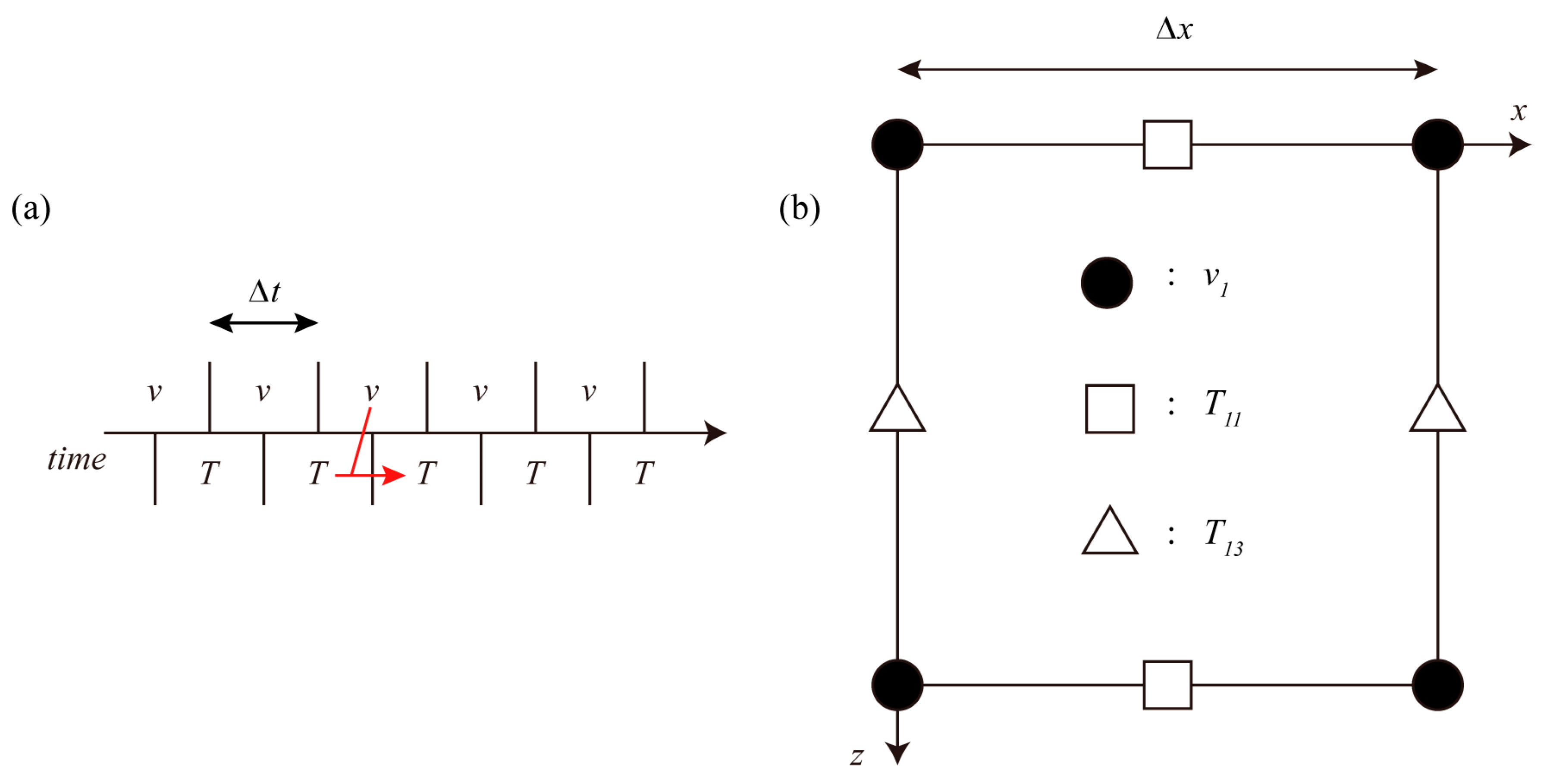
References
- Zahid, S.; Bhatti, A.A.; Ahmad Khan, H.; Ahmad, T. Development of Unconventional Gas Resources: Stimulation Perspective. In Proceedings of the Production and Operations Symposium, Oklahoma City, OK, USA, 31 March–3 April 2007; Society of Petroleum Engineers: Dallas, TX, USA, 2007. [Google Scholar]
- Jia, C.; Zheng, M.; Zhang, Y. Unconventional hydrocarbon resources in China and the prospect of exploration and development. Pet. Explor. Dev. 2012, 39, 139–146. [Google Scholar] [CrossRef]
- Stark, P.H.; Chew, K.; Fryklund, B. The role of unconventional hydrocarbon resources in shaping the energy future. In Proceedings of the IPTC 2007 International Petroleum Technology Conference, Dubai, UAE, 4–6 December 2007; Volume 3, pp. 1876–1881. [Google Scholar]
- Prasad, M.; Pal-Bathija, A.; Johnston, M.; Rydzy, M.; Batzle, M. Rock physics of the unconventional. Lead. Edge 2009, 28, 34–38. [Google Scholar] [CrossRef]
- Vernik, L.; Nur, A. Ultrasonic velocity and anisotropy of hydrocarbon source rocks. Geophysics 1992, 57, 727–735. [Google Scholar] [CrossRef]
- Johnston, J.E.; Christensen, N.I. Seismic anisotropy of shales. J. Geophys. Res. Solid Earth 1995, 100, 5991–6003. [Google Scholar] [CrossRef]
- Grechka, V.; Yaskevich, S. Azimuthal anisotropy in microseismic monitoring: A Bakken case study. Geophysics 2014, 79, KS1–KS12. [Google Scholar] [CrossRef]
- Ong, O.N.; Schmitt, D.R.; Kofman, R.S.; Haug, K. Static and dynamic pressure sensitivity anisotropy of a calcareous shale. Geophys. Prospect. 2016, 64, 875–897. [Google Scholar] [CrossRef]
- Liu, X.-W.; Guo, Z.-Q.; Liu, C.; Liu, Y.-W. Anisotropy rock physics model for the Longmaxi shale gas reservoir, Sichuan Basin, China. Appl. Geophys. 2017, 14, 21–30. [Google Scholar] [CrossRef]
- Wang, Y.; Li, C.H. Investigation of the P- and S-wave velocity anisotropy of a Longmaxi formation shale by real-time ultrasonic and mechanical experiments under uniaxial deformation. J. Pet. Sci. Eng. 2017, 158, 253–267. [Google Scholar] [CrossRef]
- Zhang, F.; Li, X.; Qian, K. Estimation of anisotropy parameters for shale based on an improved rock physics model, part 1: Theory. J. Geophys. Eng. 2017, 14, 143–158. [Google Scholar] [CrossRef]
- Zhang, Y.Y.; Jin, Z.J.; Chen, Y.Q.; Liu, X.W.; Han, L.; Jin, W.J. Pre-stack seismic density inversion in marine shale reservoirs in the southern Jiaoshiba area, Sichuan Basin, China. Pet. Sci. 2018, 15, 484–497. [Google Scholar] [CrossRef]
- Carcione, J.M.; Helle, H.B.; Zhao, T. Effects of attenuation and anisotropy on reflection amplitude versus offset. Geophysics 1998, 63, 1652–1658. [Google Scholar] [CrossRef]
- King, A.; Talebi, S. Anisotropy Effects on Microseismic Event Location. Pure Appl. Geophys. 2007, 164, 2141–2156. [Google Scholar] [CrossRef]
- Warpinski, N.R.; Waltman, C.K.; Du, J.; Ma, Q. Anisotropy Effects in Microseismic Monitoring. In Proceedings of the SPE Annual Technical Conference and Exhibition, New Orleans, LA, USA, 4–7 October 2009; Society of Petroleum Engineers: Dallas, TX, USA, 2009. [Google Scholar]
- Tsvankin, I.; Gaiser, J.; Grechka, V.; van der Baan, M.; Thomsen, L. Seismic anisotropy in exploration and reservoir characterization: An overview. Geophysics 2010, 75, 75A15–75A29. [Google Scholar] [CrossRef]
- Sun, W.; Fu, L.; Guan, X.; Wei, W. A study on anisotropy of shale using seismic forward modeling in shale gas exploration. Chin. J. Geophys. 2013, 56, 961–970. [Google Scholar]
- Meléndez-Martínez, J.; Schmitt, D.R. A comparative study of the anisotropic dynamic and static elastic moduli of unconventional reservoir shales: Implication for geomechanical investigations. Geophysics 2016, 81, D253–D269. [Google Scholar] [CrossRef]
- Malehmir, R.; Schmitt, D.R. ARTc: Anisotropic reflectivity and transmissivity calculator. Comput. Geosci. 2016, 93, 114–126. [Google Scholar] [CrossRef]
- Malehmir, R.; Schmitt, D.R. Acoustic Reflectivity From Variously Oriented Orthorhombic Media: Analogies to Seismic Responses From a Fractured Anisotropic Crust. J. Geophys. Res. Solid Earth 2017, 122, 10069–10085. [Google Scholar] [CrossRef]
- Virieux, J. SH-wave propagation in heterogeneous media: Velocity-stress finite-difference method. Geophysics 1984, 49, 1933–1942. [Google Scholar] [CrossRef]
- Virieux, J. P-SV wave propagation in heterogeneous media: Velocity-stress finite-difference method. Geophysics 1986, 51, 889–901. [Google Scholar] [CrossRef]
- Qin, Y.; Zhang, Z.; Li, S. CDP mapping in tilted transversely isotropic (TTI) media. Part I: Method and effectiveness. Geophys. Prospect. 2003, 51, 315–324. [Google Scholar]
- Guo, P.; McMechan, G.A. Sensitivity of 3D 3C synthetic seismograms to anisotropic attenuation and velocity in reservoir models. Geophysics 2017, 82, T79–T95. [Google Scholar] [CrossRef]
- Thomsen, L. Weak elastic anisotropy. Geophysics 1986, 51, 1954–1966. [Google Scholar] [CrossRef]
- Tsingas, C.; Vafidis, A.; Kanasewich, E.R. Elastic Wave Propagation in Transversely Isotropic Media Using Finite Differences. Geophys. Prospect. 1990, 38, 933–949. [Google Scholar] [CrossRef]
- Graves, R.W. Simulating seismic wave propagation in 3D elastic media using staggered-grid finite differences. Bull. Seismol. Soc. Am. 1996, 86, 1091–1106. [Google Scholar]
- Okaya, D.A.; McEvilly, T.V. Elastic wave propagation in anisotropic crustal material possessing arbitrary internal tilt. Geophys. J. Int. 2003, 153, 344–358. [Google Scholar] [CrossRef]
- Wang, L.; Chang, X.; Wang, Y. Forward modeling of pseudo P waves in TTI medium using staggered grid. Chin. J. Geophys. 2016, 59, 1046–1058. [Google Scholar]
- Kristek, J.; Moczo, P.; Archuleta, R.J. Efficient Methods to Simulate Planar Free Surface in the 3D 4th-Order Staggered-Grid Finite-Difference Schemes. Stud. Geophys. Geod. 2002, 46, 355–381. [Google Scholar] [CrossRef]
- Danggo, M.Y.; Mungkasi, S. A staggered grid finite difference method for solving the elastic wave equations. J. Phys. Conf. Ser. 2017, 909, 0–5. [Google Scholar] [CrossRef]
- Smith, J.O., III. Mathematics of the Discrete Fourier Transform (DFT): With Audio Applications, 2nd ed.; W3K Publishing: Stanford, CA, USA, 2007; ISBN 978-0974560748. [Google Scholar]
- Liu, Y.; Sen, M.K. An implicit staggered-grid finite-difference method for seismic modelling. Geophys. J. Int. 2009, 179, 459–474. [Google Scholar] [CrossRef]
- Bossy, E.; Talmant, M.; Laugier, P. Three-dimensional simulations of ultrasonic axial transmission velocity measurement on cortical bone models. J. Acoust. Soc. Am. 2004, 115, 2314–2324. [Google Scholar] [CrossRef]
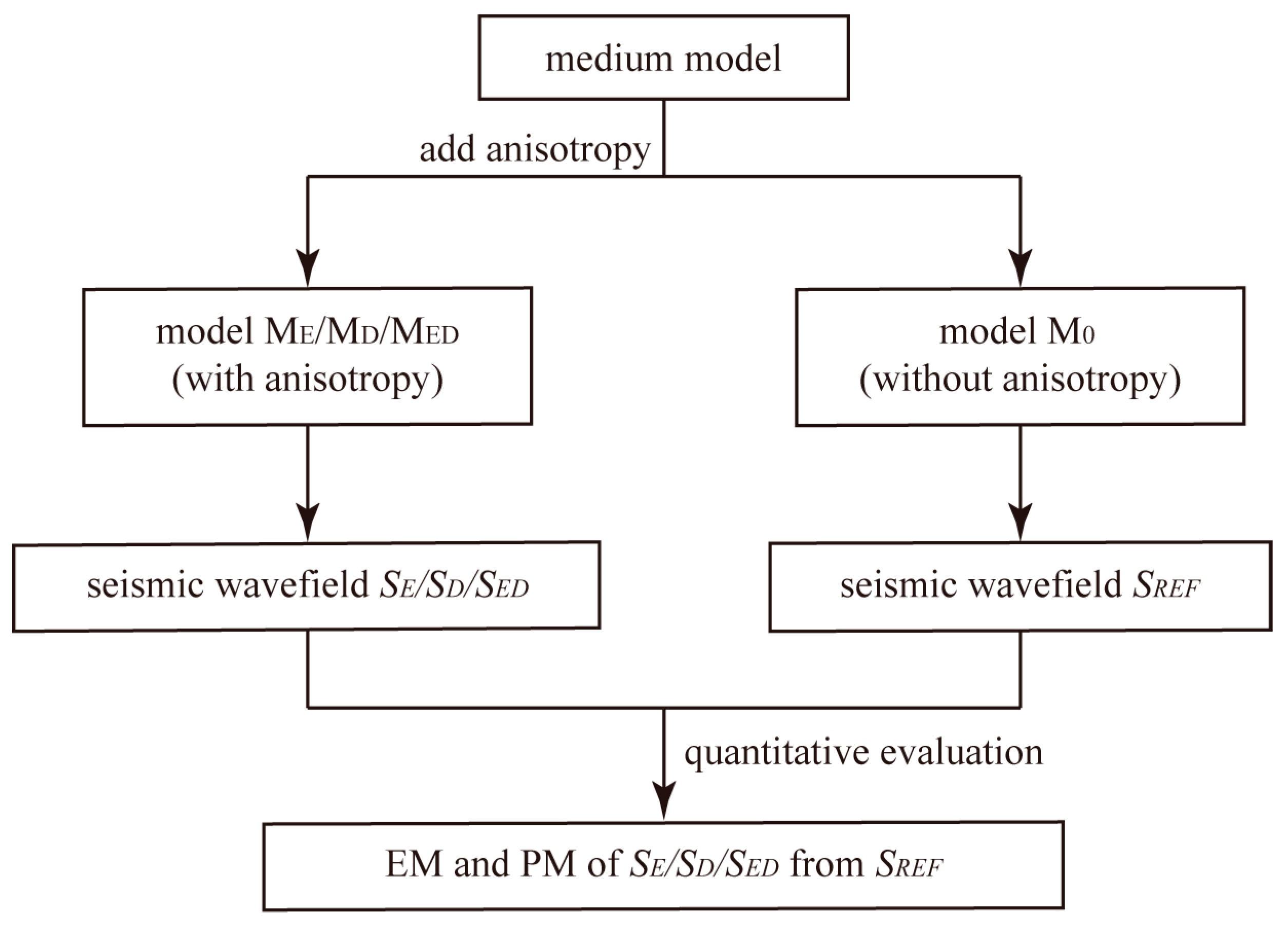
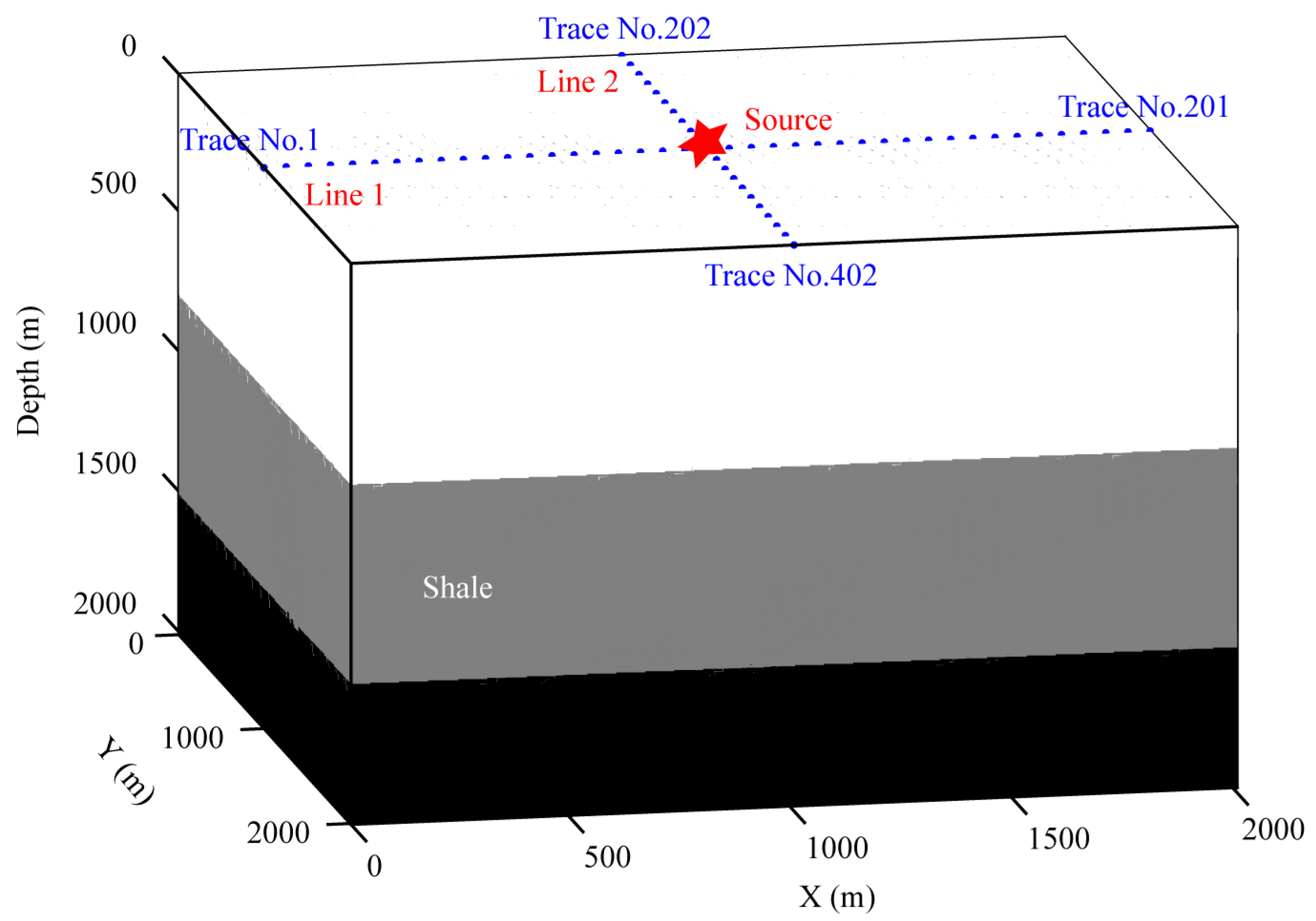
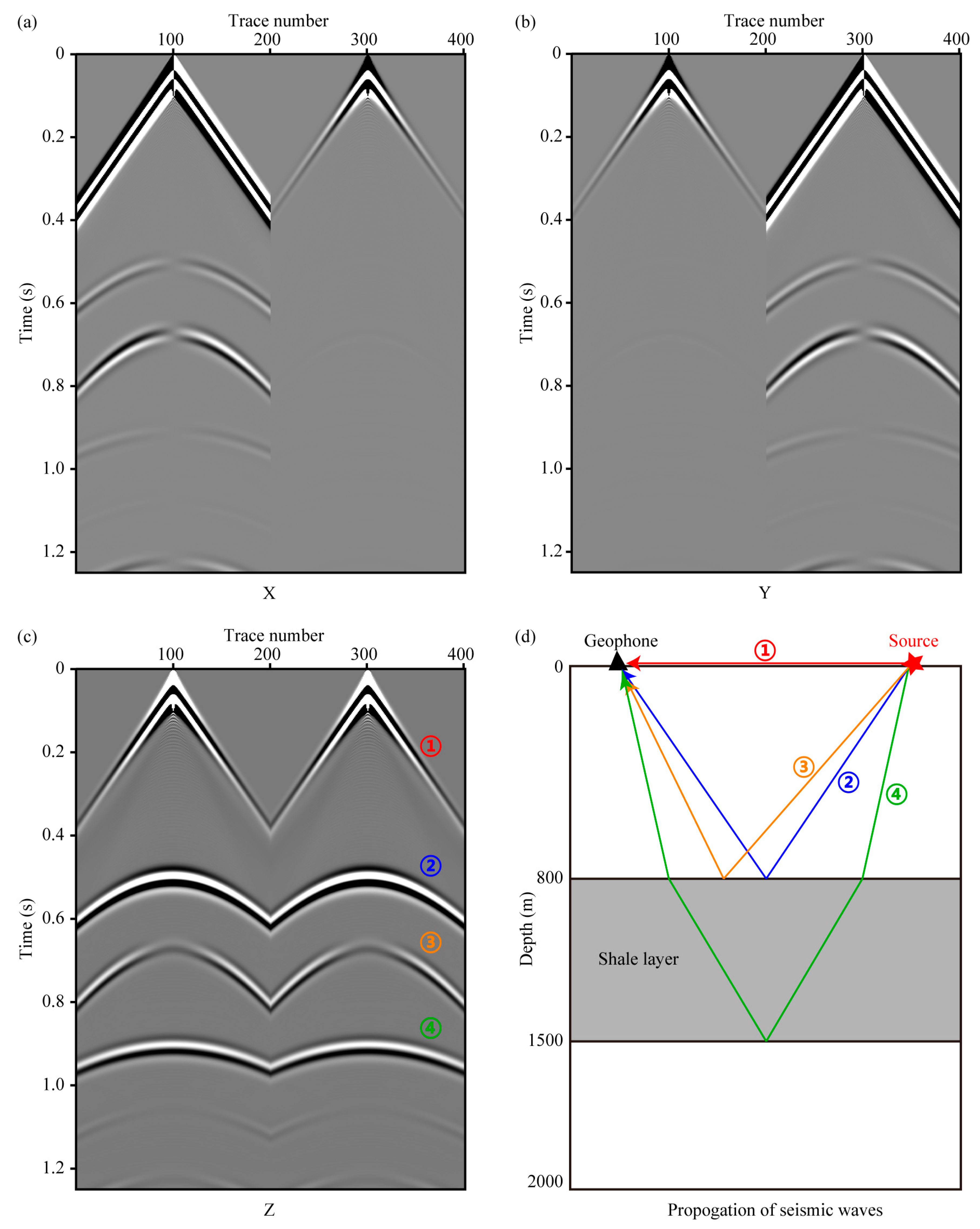
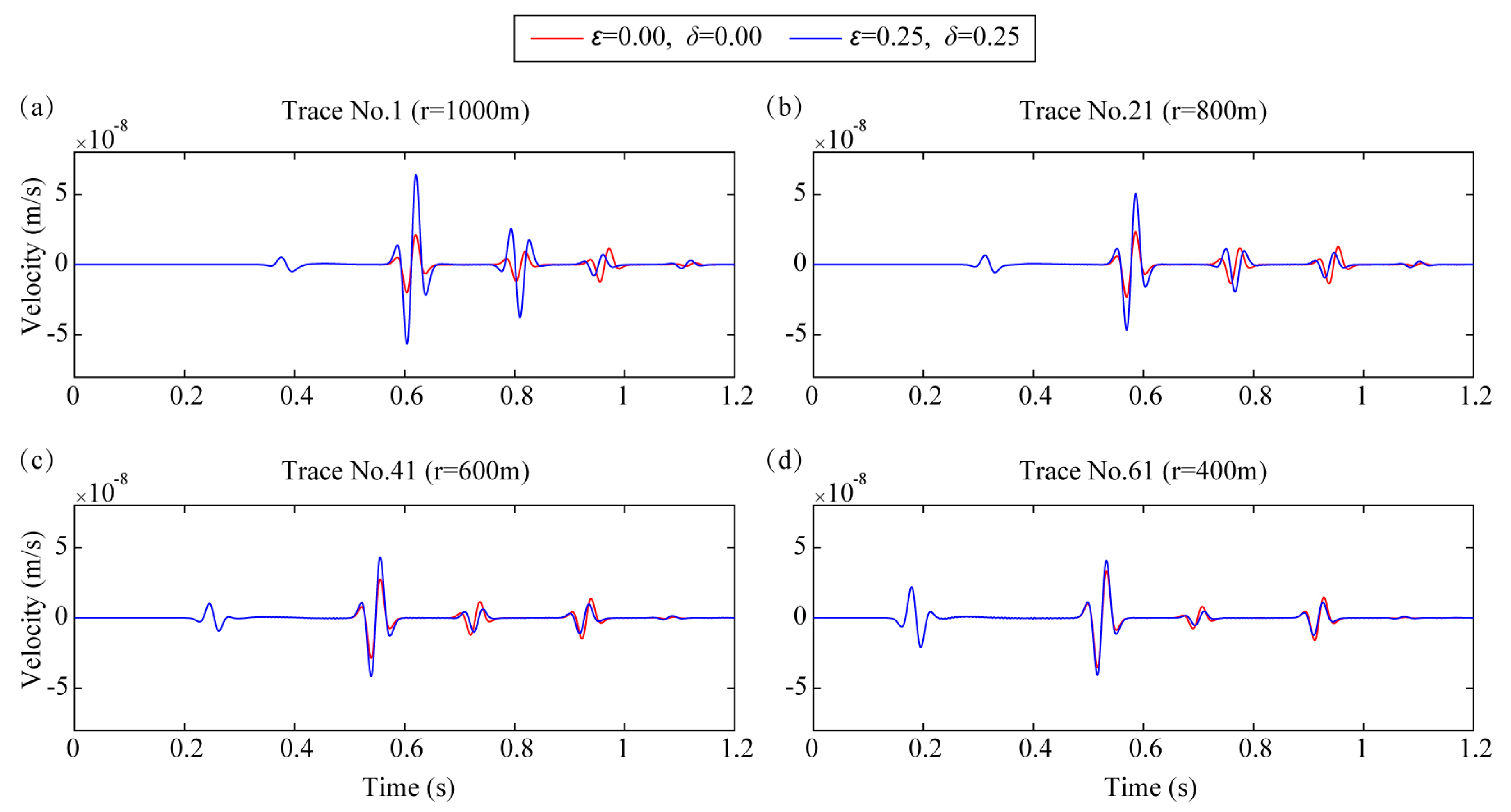
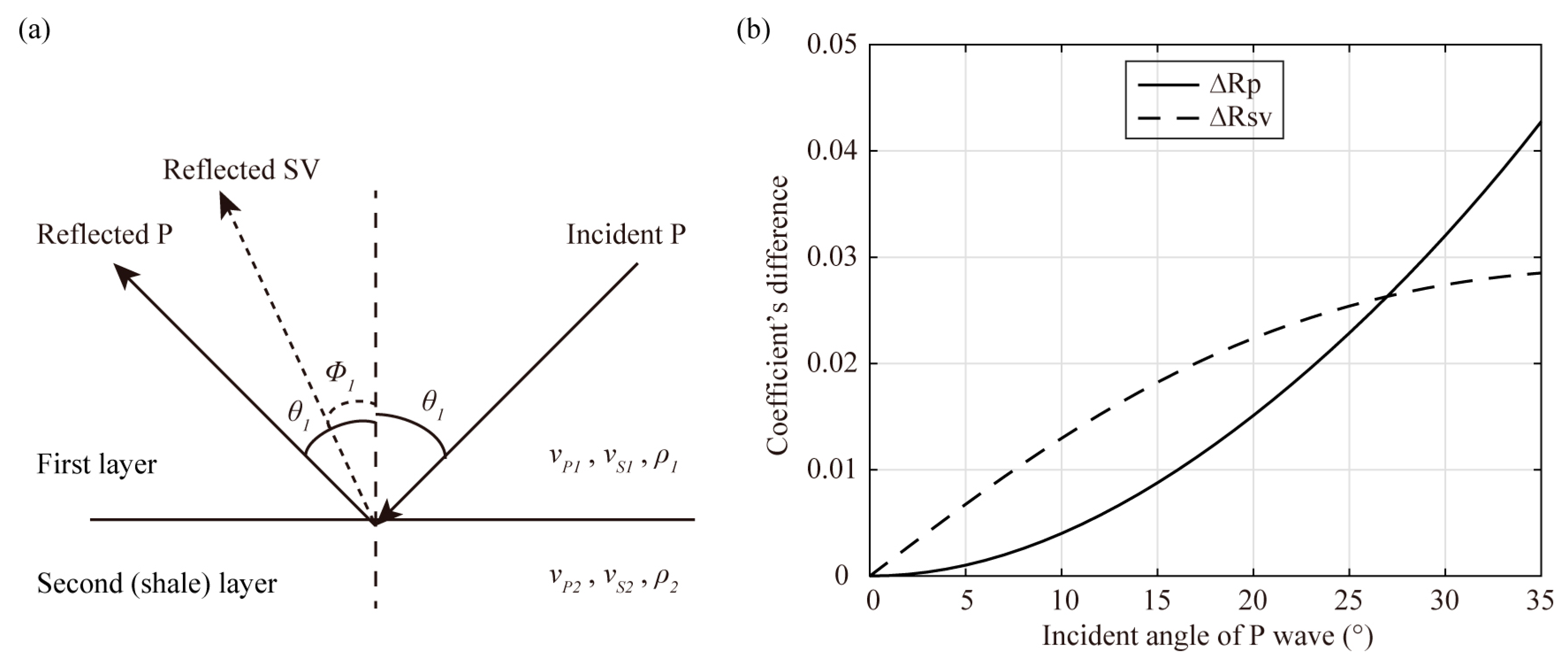
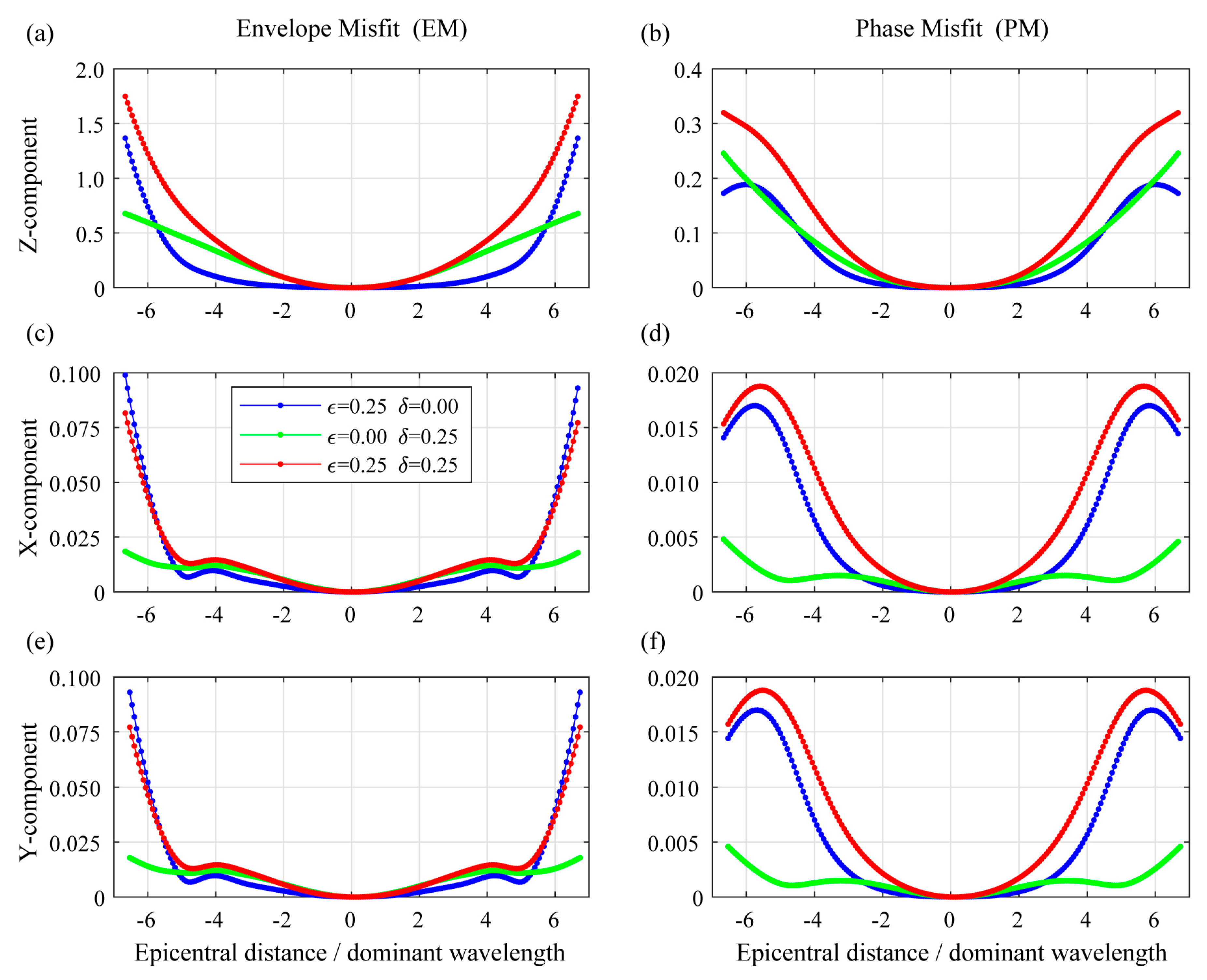
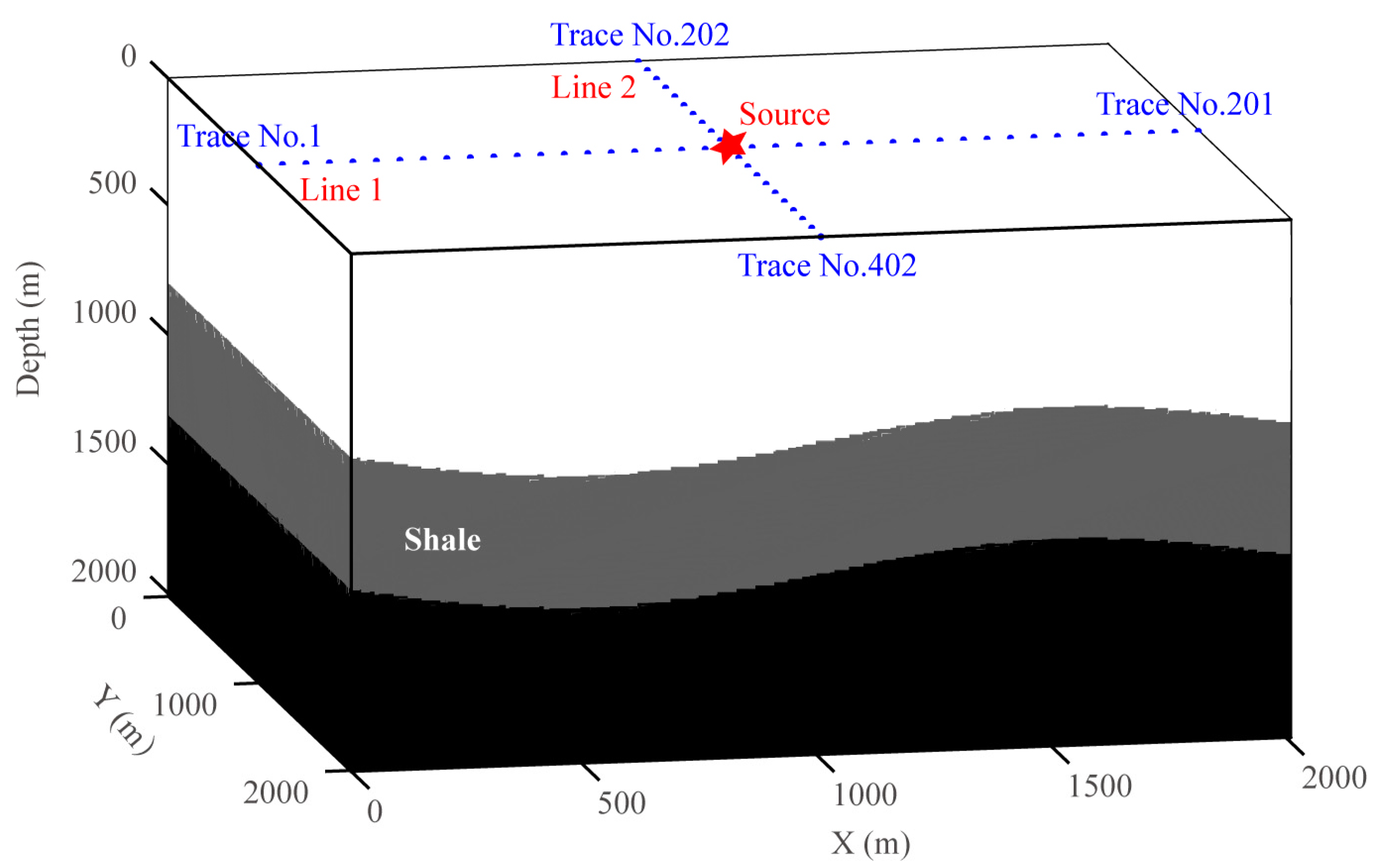

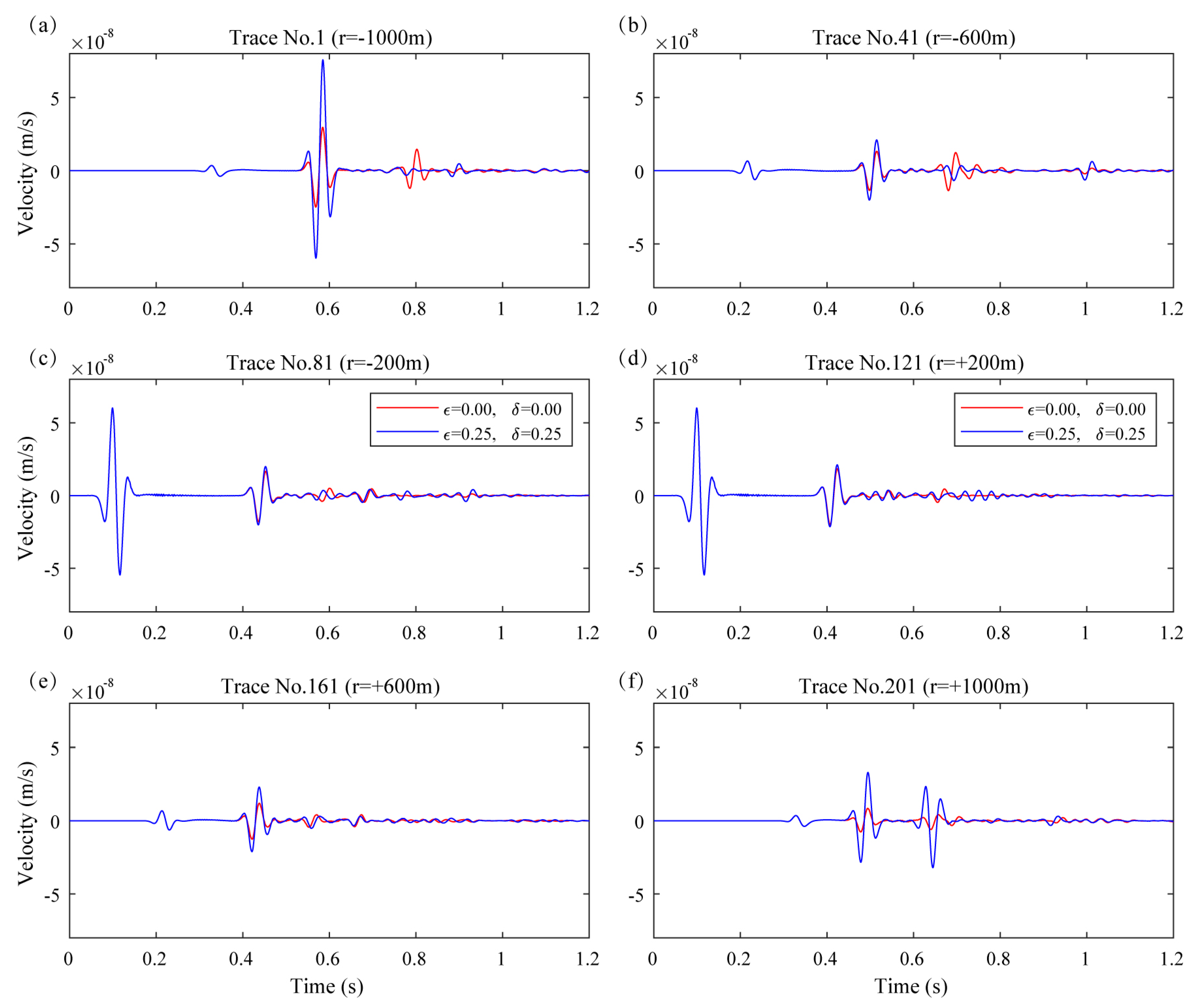
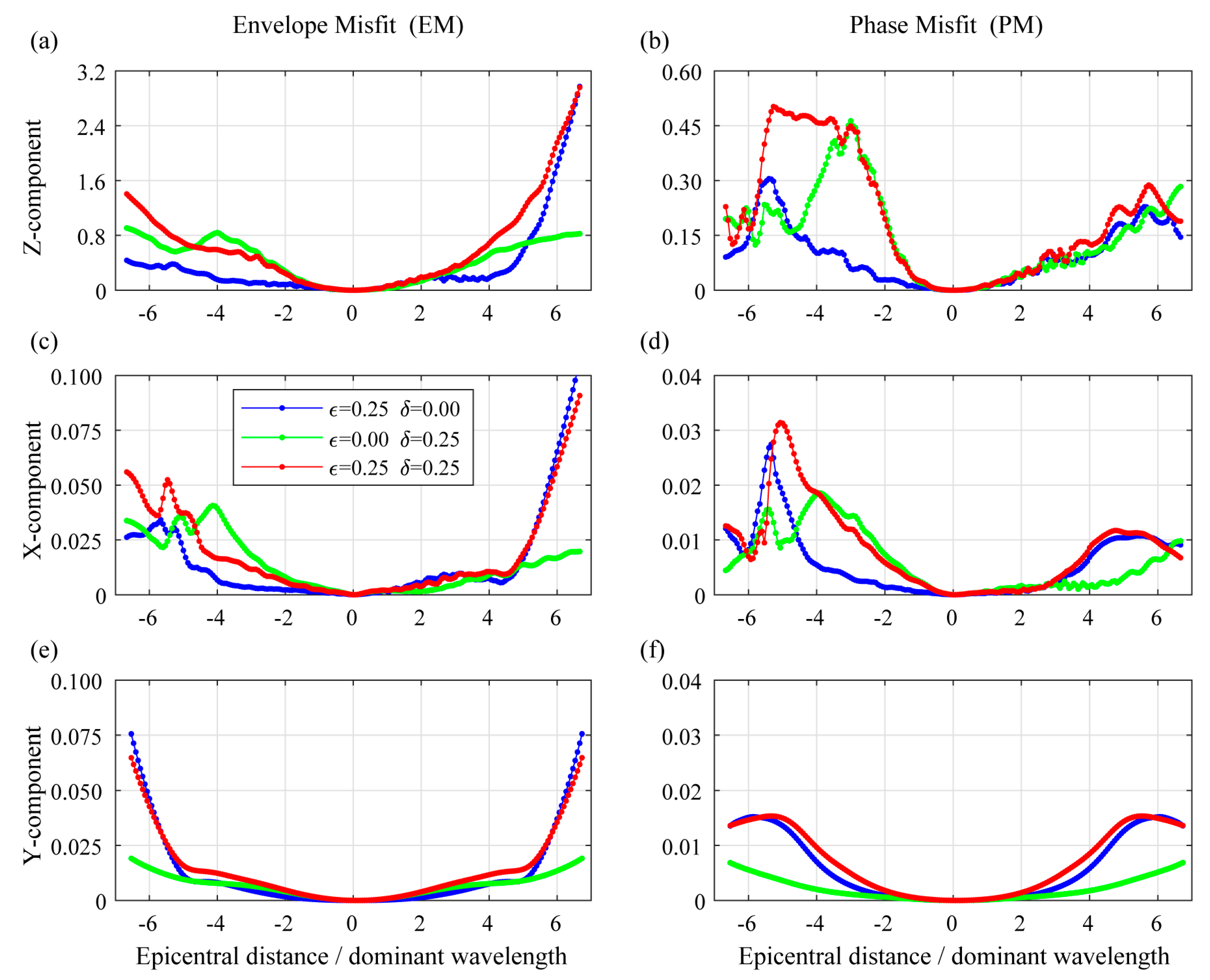
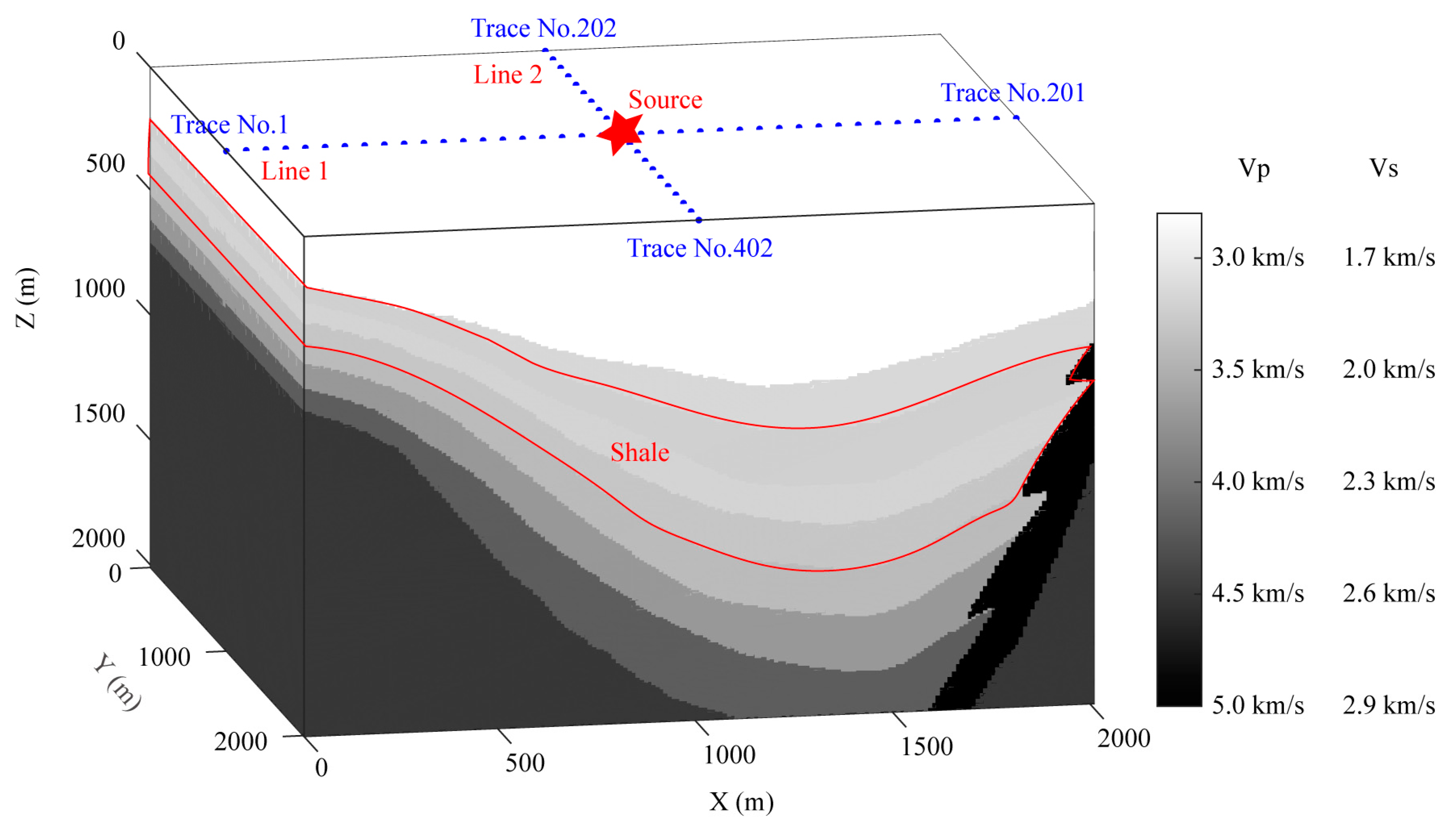
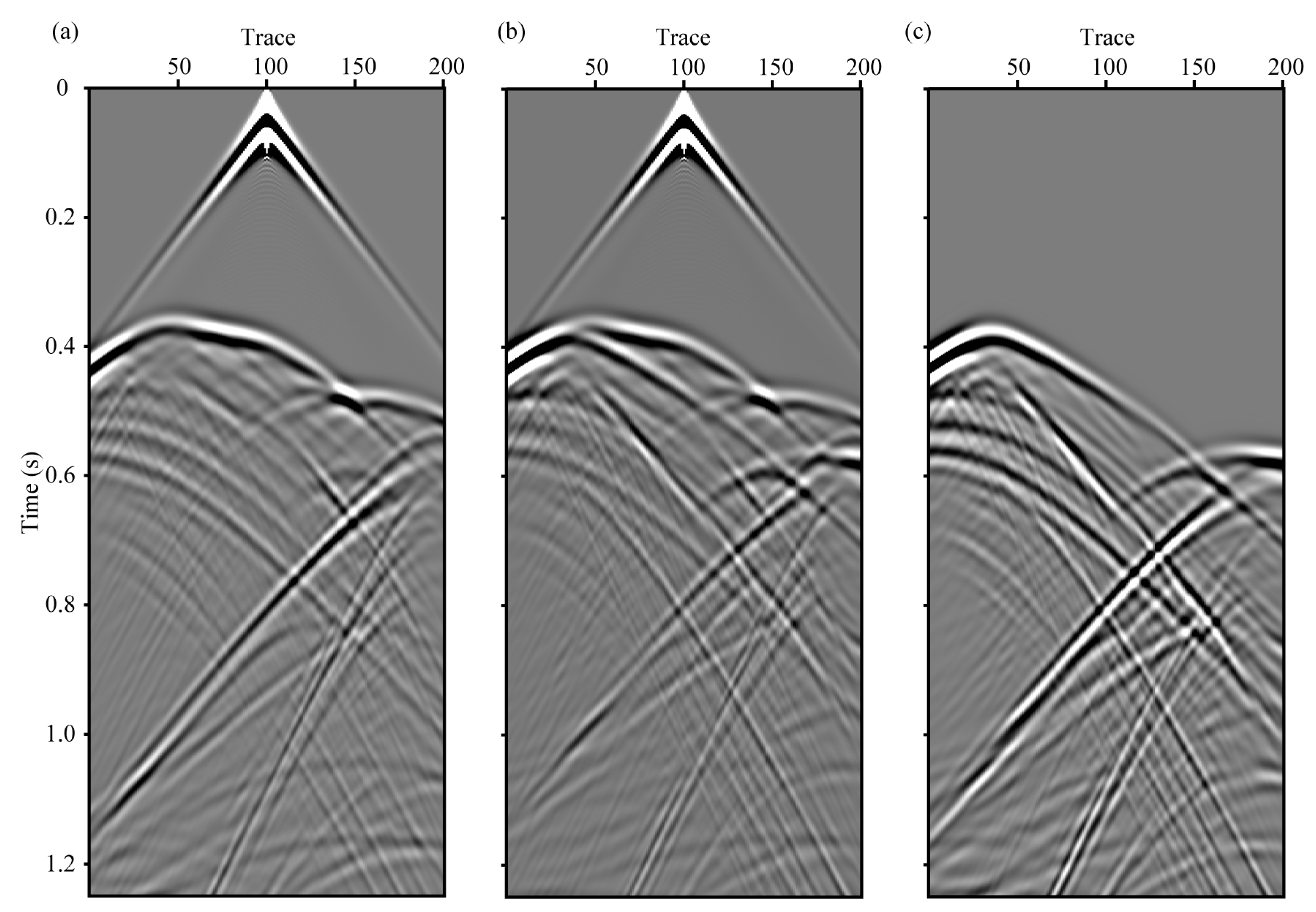
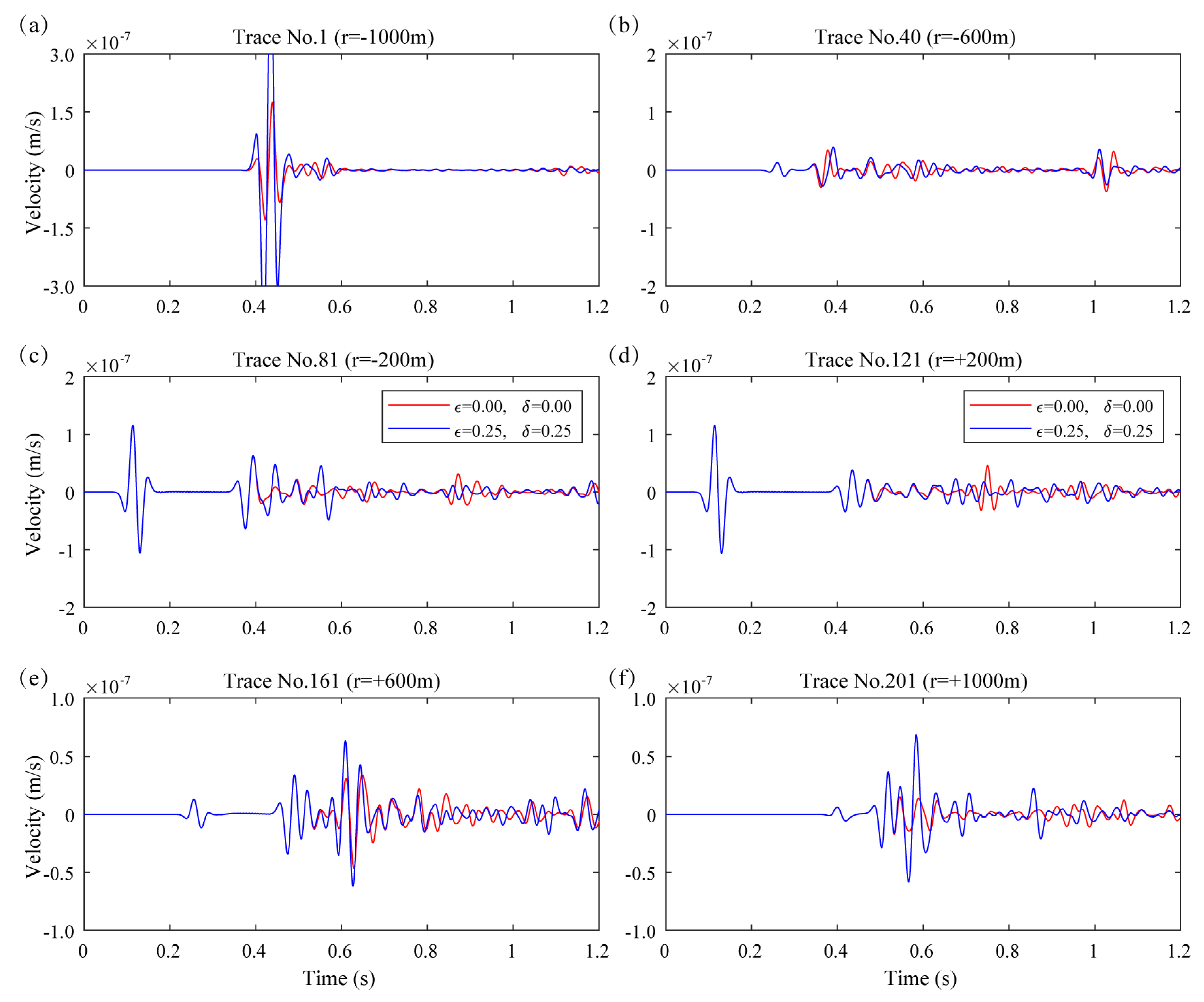
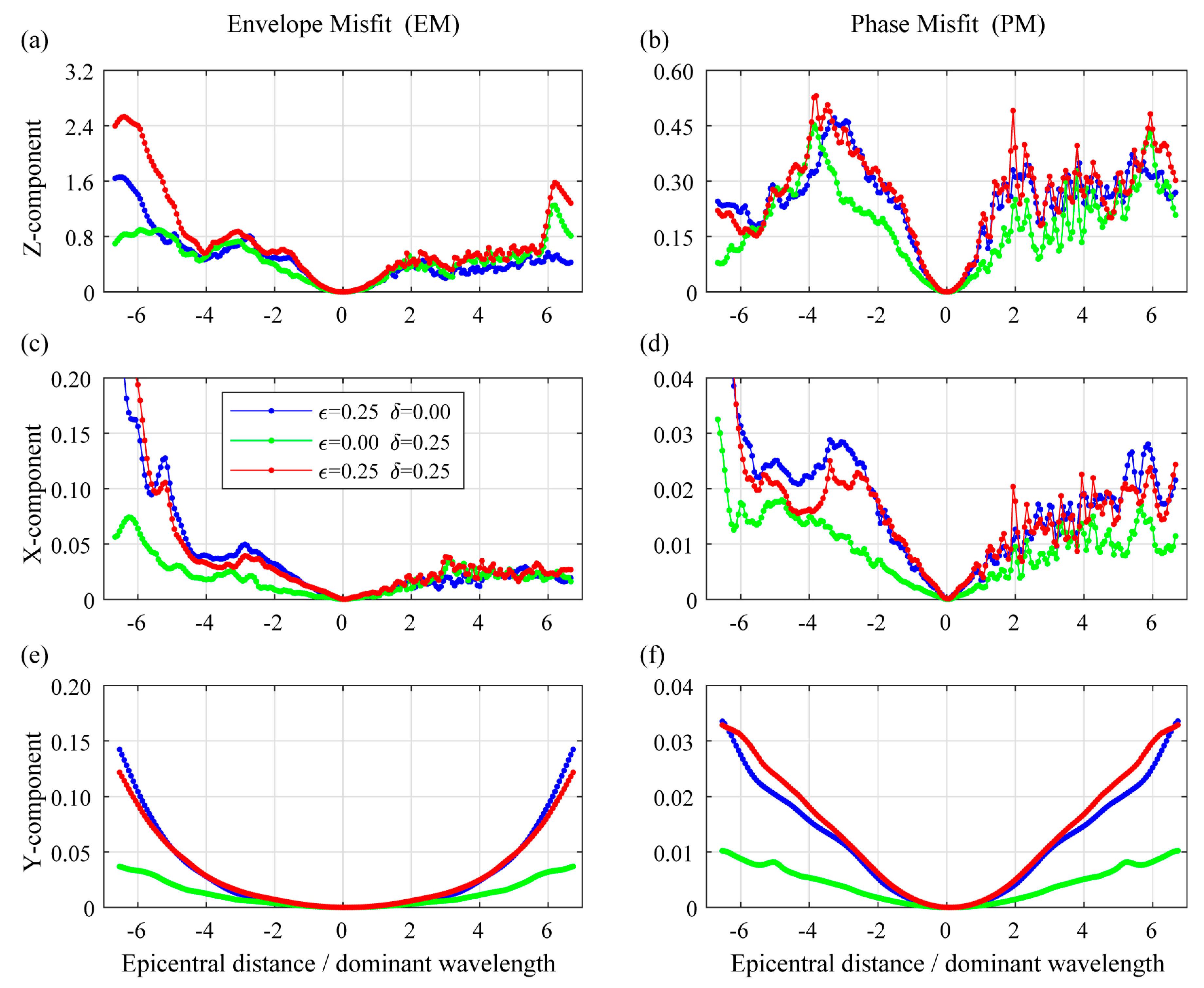
| Layer | Depth (m) | VP (m/s) | VS (m/s) | Density (g/cm3) |
|---|---|---|---|---|
| 1 | 0~800 | 3000 | 1700 | 2.0 |
| 2 | 800~1500 | 3500 | 2000 | 2.3 |
| 3 | 1500~2000 | 4000 | 2300 | 2.4 |
| Layer | Depth (m) | Thickness (m) | VP (m/s) | VS (m/s) | Density (g/cm3) |
|---|---|---|---|---|---|
| 1 | 0 | 700–900 | 3000 | 1700 | 2.0 |
| 2 | 800 | 500 | 3500 | 2000 | 2.3 |
| 3 | 1500 | 600–800 | 4000 | 2300 | 2.4 |
© 2019 by the authors. Licensee MDPI, Basel, Switzerland. This article is an open access article distributed under the terms and conditions of the Creative Commons Attribution (CC BY) license (http://creativecommons.org/licenses/by/4.0/).
Share and Cite
Li, H.; Liu, X.; Chang, X.; Wu, R.; Liu, J. Impact of Shale Anisotropy on Seismic Wavefield. Energies 2019, 12, 4412. https://doi.org/10.3390/en12234412
Li H, Liu X, Chang X, Wu R, Liu J. Impact of Shale Anisotropy on Seismic Wavefield. Energies. 2019; 12(23):4412. https://doi.org/10.3390/en12234412
Chicago/Turabian StyleLi, Han, Xiwu Liu, Xu Chang, Ruyue Wu, and Jiong Liu. 2019. "Impact of Shale Anisotropy on Seismic Wavefield" Energies 12, no. 23: 4412. https://doi.org/10.3390/en12234412
APA StyleLi, H., Liu, X., Chang, X., Wu, R., & Liu, J. (2019). Impact of Shale Anisotropy on Seismic Wavefield. Energies, 12(23), 4412. https://doi.org/10.3390/en12234412




